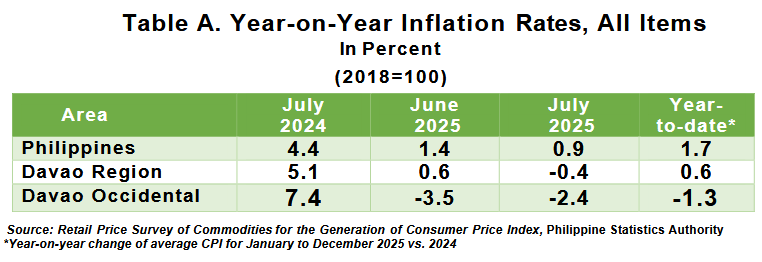
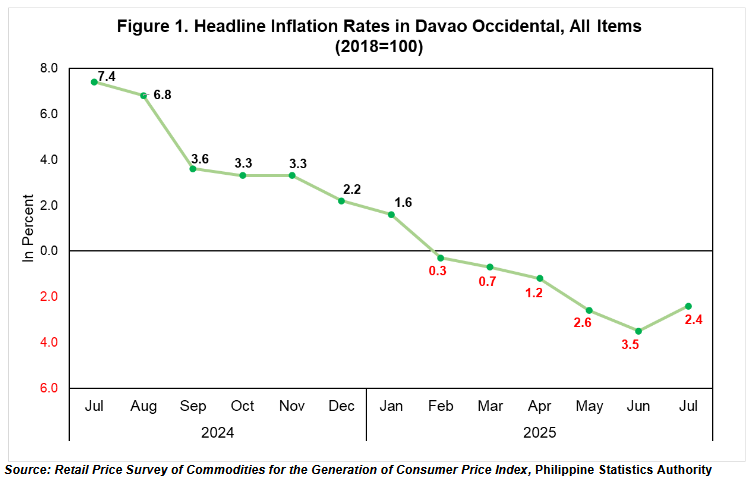
The Davao Occidental annual headline inflation slightly increased to negative 2.4 percent in July 2025 from negative 3.5 percent in June 2025. In July 2024, the inflation rate was higher at 7.4 percent. (Table A and Figure 1)
The main sources of uptrend of the province inflation in July 2025 were contributed by the faster movement of prices of the following commodity groups;
a. Furnishings, household equipment and routine household maintenance, from 4.7 percent to 5.2 percent;
b. Alcohol beverages and tobacco, from 4.1 percent to 4.3 percent;
c. Housing, water, electricity, gas and other fuels, from 3.0 percent to 3.6 percent;
d. Education services, from 3.1 percent to 3.4 percent;
e. Transport, from negative 2.3 percent to negative 1.8 percent; and
f. Food and non-alcoholic beverages, from negative 9.2 percent to negative 7.4 percent.
In contrast, slower annual inflation was noted in the indices of the following commodity groups during the month;
a. Recreation, sport and culture, from 11.1 percent to 10.0 percent;
b. Clothing and footwear, from 4.2 to 3.5 percent; and
c. Health, from 4.1 to 3.5 percent.
On the other hand, the following commodity groups retained their inflation with the previous month;
a. Restaurant and accommodation services, at 14.3 percent; and
b. Information and communication, at 1.0 percent.
While the financial services, and personal care, and miscellaneous goods and services
and remained at zero growth during the month. (Tables B)
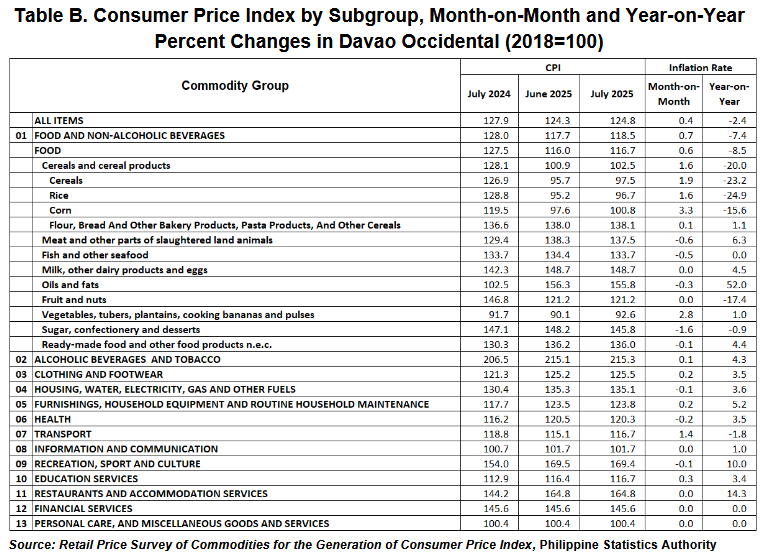
The food inflation at the provincial level increased to negative 8.5 percent in July 2025 from negative 10.3 percent in June 2025. In July 2024, the food inflation was higher at 10.8 percent.
The acceleration of food inflation in July 2025 were contributed by the faster inflation of the following food groups;
a. Oils and fats from 50.3 percent to 52.0 percent;
b. Vegetables, tubers, plantains, cooking bananas and pulses from negative 6.8 percent to 1.0 percent;
c. Fish and other seafoods, from negative 2.7 percent to 0.0 percent;
d. Sugar, confectionery and desserts from negative 5.8 percent to negative 0.9 percent;
e. Corn, from negative 17.4 percent to negative 15.6 percent; and
f. Rice, from negative 26.8 percent to negative 24.9 percent.
On the other hand, compared with their previous month’s inflation rates, lower annual growth rates during the month were observed on the following food groups;
a. Milk, other dairy products and eggs, from 4.8 percent to 4.5 percent;
b. Ready-made food and other food products n.e.c from 5.3 percent to 4.4 percent; and
c. Flour, bread and other bakery products, from 1.3 percent to 1.1 percent.
While fruits and nut, and meat and other parts of slaughtered land animals retained its previous month inflation at negative 17.4 percent and 6.3 percent respectively. (Table C)
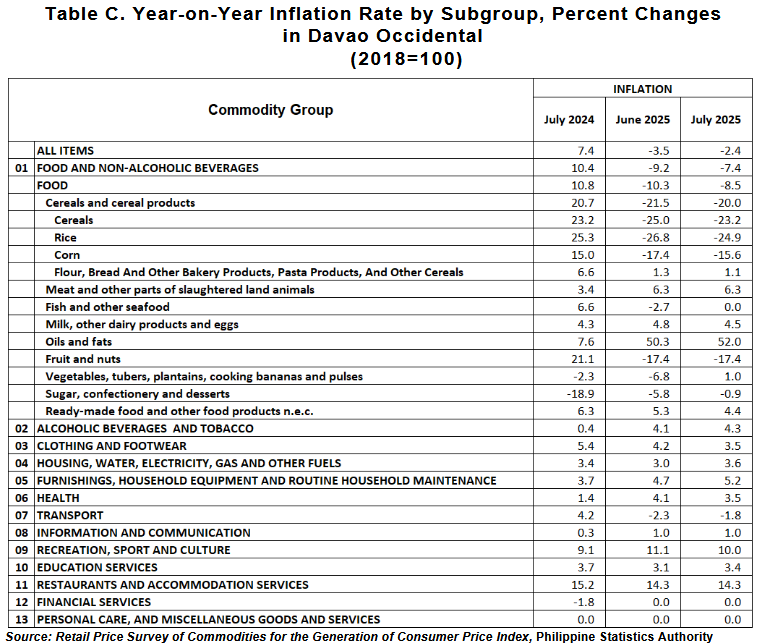
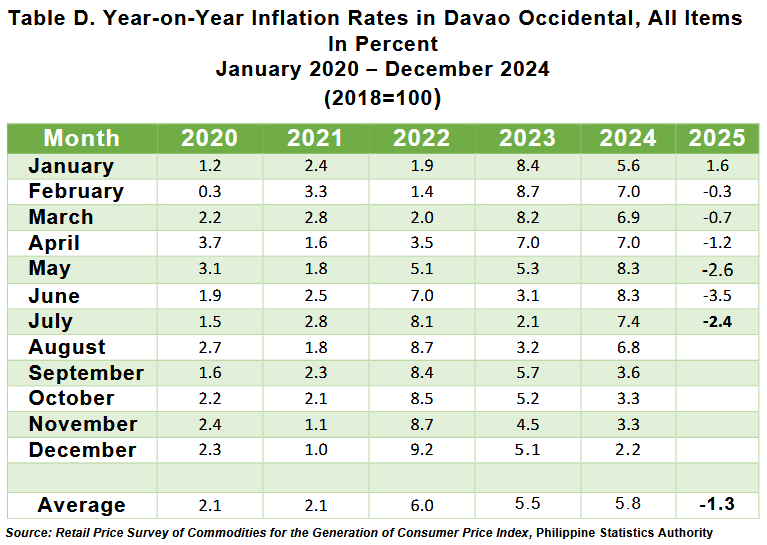
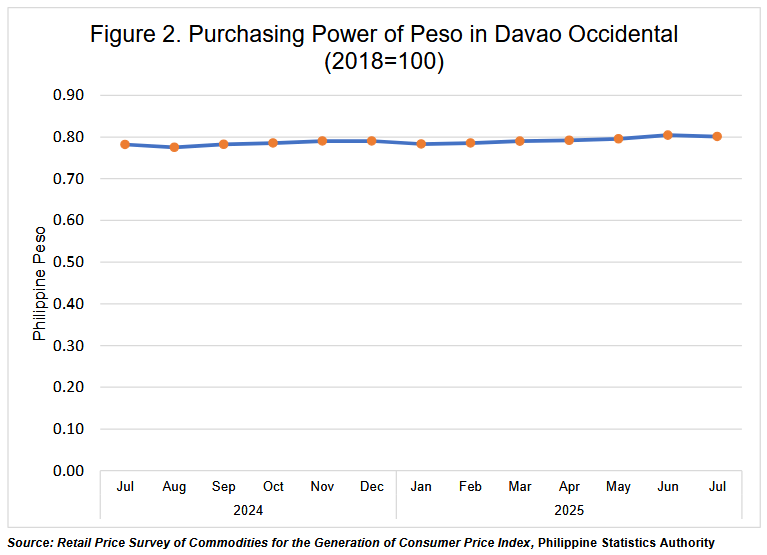
In addition, the July 2025 Purchasing Power of Peso (PPP) in Davao Occidental remained at 0.80 cents. (Figure 2)
Technical Notes:
Consumer Price Index (CPI) - The CPI is an indicator of the change in the average retail prices of a fixed basket of goods and services commonly purchased by households relative to a base year.
Inflation Rate (IR) - The inflation rate is the annual rate of change, or the year-on-year change of the CPI expressed in percent. Inflation is interpreted in terms of declining purchasing power of money.
Headline Inflation - measures changes in the cost of living based on movements in the prices of a specified basket of major commodities. It refers to the annual rate of change or the year-on-year change in the Consumer Price Index (CPI).
Purchasing Power of the Peso (PPP) - The purchasing power of the peso shows how much the peso in the base period is worth in the current period. It is computed as the reciprocal of the CPI for the period under review multiplied by 100.
Approved for Release:
JESSIE A. MADULIN
Chief Statistical Specialist
